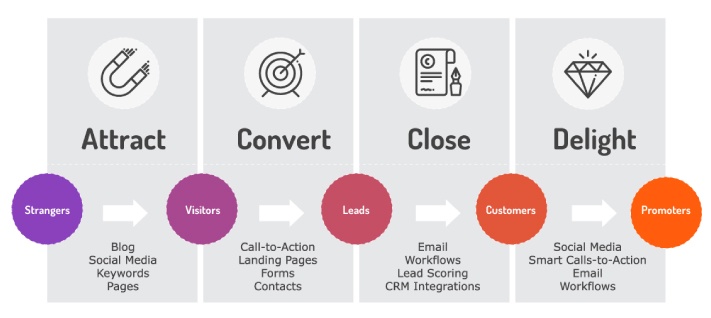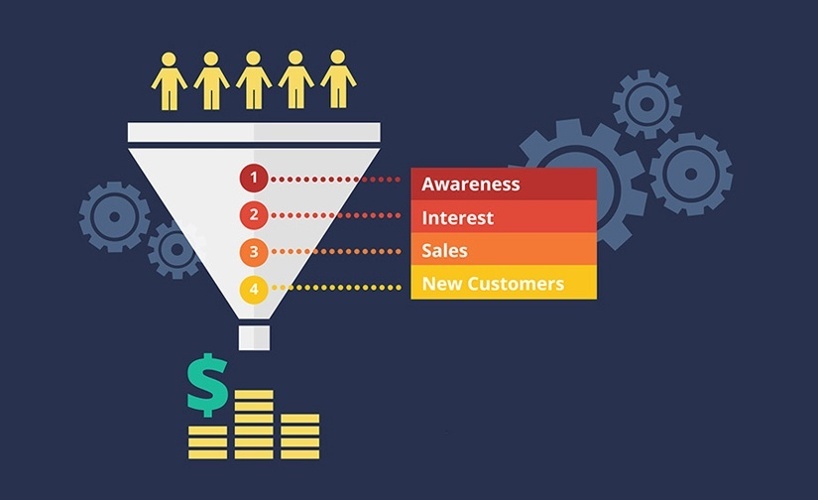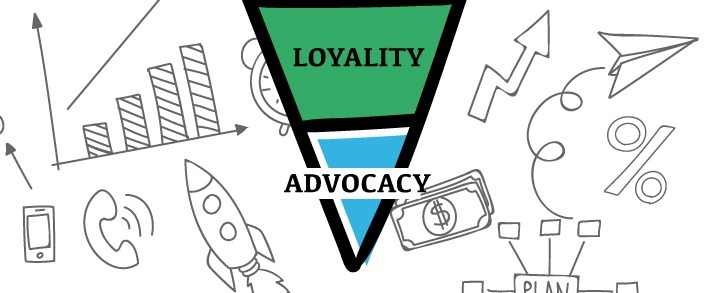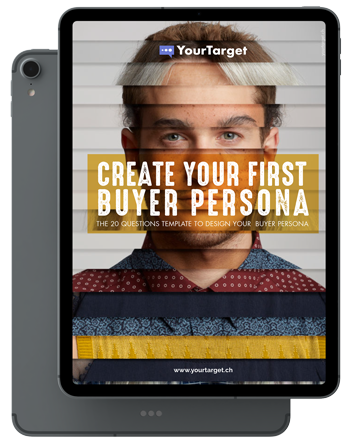The customer journey should be a priority for your business; people don’t buy products or services, they buy experiences! They buy the feelings that occur when they establish contact with your company, from the first time they meet your company (for example when they discover your website) until they decide to buy your products or services. If you make them feel comfortable and happy, they will suggest your products or services to their friends and share news about your company on social channels. If you give them a good experience they will become your best ambassadors.
If you are asking yourself how you can improve the customer journey, the answer is “inbound methodology”. In this article you’ll discover how the inbound methodology can improve your customer journey.
In order to improve it, you have to wear his/her shoes, and ask yourself some important questions:
When a person is searching on Google for products or services like yours, does she/he find your website easily? Is your website placed among the first google results?
When your customer visits your website, does he/she easily find the information they need? Or is the research quite frustrating? If your customer wants to know more about your products or services, do you provide him/her with useful resources such as blog posts, e-books, demos, free trials and so on?
Giving answers to all these questions is vital for your company, because then you are able to create a very good customer journey, and truly understand what your prospect needs.
In order to get this result you have to work hard and think how you can improve your customer journey. The inbound methodology is a very good ally because it enables you to really understand your customers needs and to satisfy them with valuable content.
How does it work? How does the inbound methodology improve your customer journey?
The inbound marketing methodology develops into four steps: attract, convert, close, delight. Each stage is characterized by specific practices and it is based on the concept that you don’t have to interrupt people with your commercials, but your company should be easily found by people who are interested in products and services like yours, thanks to your valuable contents.
Let’s go deep into this methodology and let’s discover the way it can improve a customer journey.
As mentioned above, here are the fundamentals of the inbound marketing:
It’s the opposite of the interruption methodology
Your company must develop a very good content strategy.

1. Attract
At this stage it’s important for your company to be easily found by people who are looking for the same products or services as yours.
In order to reach this primary goal you should change the way you think of your website: you should consider it a focal point in your marketplace that can attract a lot of traffic thanks to valuable contents.
To realize this objective you have to follow some best practices:
- Improve your SEO optimization;
- Add a blog to your website;
- Spread your contents through your social channels.
Seo Optimization
Remember that at this stage, in which you ”attract”, you should match the interest of people who are searching for a specific product or service. The SEO Optimization improves your Google rankings, that’s why it’s vital for your company.
It includes a lot of practices, some of them will be shown in this list:
- The structure of your website should be hierarchical and pyramidal, in order to make it easy for the search engine to scan it
- You should avoid too many subcategories and too long paths
- You should use crosslinks, i.e. the pages of your site should be linked one to each other, based on the relevance of their topics
- You should optimize the URLs of your website, their structures should mirror the hierarchical structure of your website
www.yourwebsite.it/ = Homepage
www..yourwebsite.it/category/ = Page of the first level
www.yourwebsite.it/category/sub-category/ = Page of the second level
You should optimize title and meta description by using a specific keyword in order to make easy to understand the topic of the pages for the reader or the search engine. Your title should be descriptive and precise and it must contain a specific keyword.
The meta description is a short preview of you website pages, it should be well-written, engaging, it should contain the main topics of the page and how it can help you to find the right solution.
Add a blog to your website

Thank to your SEO practices people can easily find your website; now it’s time for your company to grab your visitor’s attention with the right contents and to offer him/her a navigation path easy and simple.
This phase is very delicate because if your visitors come to your website and they don’t find what they are looking for or the navigation is very difficult, they will abandon your website after few seconds and you miss the chance to get new customers.
Your first ally is the blog for the following reasons:
- Your blog posts help to confirm you as a thought leader in your market;
- It can help you build a trustworthy relationship with your visitors;
- It helps you improve your Google rankings.
Imagine your prospect customers are looking for a specific product. At this stage they don’t need a company who wants to force them to buy their products. What they really need is a company that explains to them how their products can improve their lives and solve their problems.
For this reason it’s important at this stage to create a blog with the right content that is interesting to your customers.
The main topics for your blog:
As mentioned above, a blog helps to confirm you as a thought leader in your marketplace. In order to obtain this result you should focus on the topics you have to write about. They should match the interests of your visitors, help them to find a solution for their problems.
So what should you write about?
- How-to-articles;
- Analysis of a current industry trend or challenge;
- Announcements of upcoming events;
- List of links to other relevant articles;
- Videos, cartoons, caricatures to tell the behind-the-scenes of your company;
- Guest blog articles.
The art of measuring and tracking your blog
It’s important for your company to track the progress of your blog in order to establish which topics and/or formats must be improved and which ones not.
The metrics you should consider are:
- Number of subscribers;
- Number of visitors;
- Number of qualified leads who come from your blog;
- Number of new customers who originally found you via your blog.
The importance of social media to spread your content
When you think of your customer journey, you can easily realize that it is not linear and it’s quite fragmented. In order to be found by your prospects, your communication strategy must consider all the touch points of your company.
Some people use Google for their research, others are interested in what their friends share on a social media channels. That’s why it is so important for your company to share its valuable content on their social channels. After you have created the right contents for your blog you should share them via your social channels
“Do you provide your customers with useful resources? Do they find in your website what they need?
2. Convert
After you have attracted your visitors, the second stage of the funnel is to “convert” them into leads. In order to convert them, you have to give them a good reason to leave you their contacts. Once again it is the content that can help you with this goal. When a prospect customer finds a free resource very useful and interesting, they are encouraged to download it and to give you their contact information in exchange.
Two elements are fundamental at this stage: call-to-actions and landing pages. They should have some important characteristics. Let’s talk about them.
Call to action
A call to action must invite your visitors to accomplish a specific task:
- Download this e-book;
- Sign up to our newsletter;
- Register for our webinar.
You can use it for the following resources:
- Webinar;
- White papers and reports;
- E-book;
- Research studies;
- A free class, demo or trial offers.
How a call to action should be: best practices
In order to create a very prominent call to action you must follow these practices:
A good call to action must contain a few words; the verb you use is very important in order to make it clear for visitors which action they have to take and the result of that action.
When it’s easy to understand the advantages of the products or services and their functionalities, you can place it at the top of the page; otherwise, if the call to action refers to a new product or service, it’s better to place it at the end of the page after rich content so that the visitor is able to understand its advantages and functionality.
It should be a clickable image with a large font and highlighted by a colour.
The art of measuring and tracking your CTA
- Tracking the progress is a fundamental activity that allows you to understand the percentage of visitors who convert into qualified leads.
- A/B test is another useful activity and you’ll be surprised about the increasing percentage of leads with small changes.
Landing Pages: best practices
Here you find the best practices about a good and useful landing page:
- You have to be sure that the content of the landing page is matching the content of your call to action;
- In order to build a trustworthy relationship with your visitors, you have to use a professional image and a well written copy.

Practices to make people fill the form
Remember that the main task of your landing page is to make people fill the form. To fulfill this goal you have to follow this practices:
- Get rid of distracting navigation;
- Cut the number of offers;
- Cut the images; they could be a distraction from the main goal, i.e. to make people fill the form;
- Reduce the options and the additional information;
How to create a good form for your landing page
As mentioned above, the goal of your landing page should be to make people fill the form. So the form is an important element of the landing page.
The form should be short because the visitors are much more likely to ignore or to abandon them before completing the process. You should ask only a few questions such as name and email, and avoid asking sensitive information, because it could dramatically lower your conversation rates. If you ask your prospects questions that requires them to go elsewhere to find information, they probably won’t come back to fill the form.
Finally be sure that after the visitors have completed the form they receive an email confirmation.
If you have an e-commerce for women clothes and your prospects are looking for a specific size, you have to create a landing page only for that specific size and not to fill it with other information that is not useful for them.
Remember at this stage in which you convert visitors into leads, you need to give them free and useful resources, such as ebooks, webinars, demos, trials. In return for these free gifts they give you some useful information that can help you convert them into customers.
3. Close
The third stage of the inbound methodology is the conversion from leads to customers. In this phase are important the following steps:
- Grade the leads;
- Nurture your leads.
Your leads establish a contact with you using different channels, and they download different sources and see different pages. They are quite different!
Analyzing their differences makes it easy for you to understand if a lead is ready to buy or not.
You can give your leads a score based on the channel they used to reach you, the page they have visited, and so on.
A lead who visits your website clicking on your email link has an higher score than a lead who finds you through a Google search; the lead who visits the page “who we are” obtains a lower score than a lead who visits the products page.
For the unqualified leads (the leads that are not ready to buy) you can realize a nurturing program, through which you can continue to maintain a contact and a dialogue with them.
How can you nurture them?
You can send them a weekly or monthly e-mail with the updates about your marketplace, news and trends. Remember: even at this stage you don’t sell to them! You provide them with contents that are useful and interesting in order to create a trustworthy relationship.
You can also invite them for a demo or free trial.
Track the effectiveness of your lead nurturing programs
The measuring activity is very useful at this stage: it allows you to understand how much effective is your nurturing program. You can track the progress of it by analyzing the number of the e-mails opened and the number of subscribers that click on one of the links shown in your newsletter.
4. Delight

After you have acquired new customers the relationship with them has not come to an end. You have to keep it alive because you have to encourage them to buy from you again.
How can you do that?
You can take Amazon as an example: after you have bought a book from its e-commerce Amazon sends you an email and asks you for feedback. Later Amazon sends you another e-mail with the suggestions of other books that you could be interested in; a choice based on your previous purchase.
At this stage a good practice is for you to send emails to your customers in order to:
- Ask for a feedback;
- Update them about new products;
- Invite them to take part at to your event;
- Reward them with a gift;
- Reward them with a discount on their birthdays.
Remember: you can invite them to share their feedback on your social channels. In this way you can convert your customers into ambassadors.
Tracking the progress
At this stage it is important to measure the number of email disclosures and the number of the subscribers that click on the link shown on the email, and the number of subscribers who decided to use the discount coupon or to take the gift.
The inbound methodology guides the customer step-by-step through their journey with useful and helpful contents. Customers don’t feel the pressure to buy a product or a service, they perceive your company like a valid ally that can help them in finding the right solution for their problems.
Each Inbound Marketing campaign starts once you analyzed your marketplace and your buyer personas.
Are you ready? Begin designing your potential customers!

